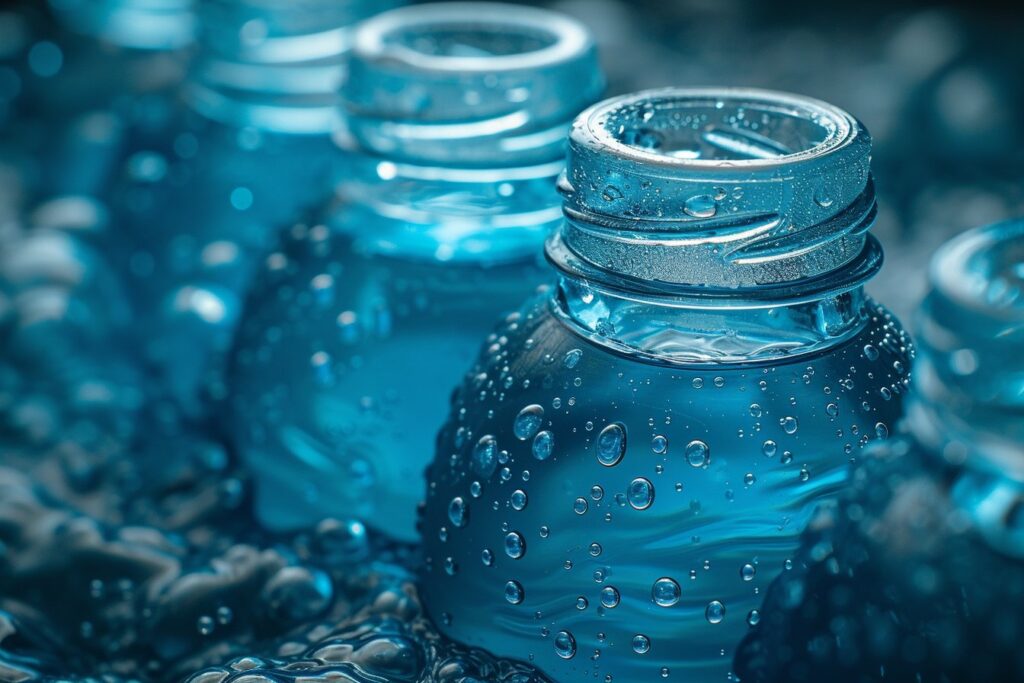What Are Nanoplastics?
Nanoplastics are tiny particles of plastic that measure less than one micron (one-millionth of a meter) in size. These miniscule particles are invisible under a microscope and 1,000 times smaller than the average human hair. Their presence has been detected in various environments, including air, soil, and water sources. Most recently, a groundbreaking study discovered that bottled water contains thousands of nanoplastic particles – stirring concerns about their potential health risks on humans.
A Startling Discovery in Bottled Water
Researchers have found that one liter of bottled water contained an average of 240,000 plastic particles derived from seven different types of plastics. A staggering 90% of these particles were identified as nanoplastics, with the remaining 10% being microplastics. This new evidence highlights the widespread presence of nanoplastics and raises significant concerns for public health due to their potential harmful effects.
How Do Nanoplastics Enter Our Bodies?
When we consume bottled water containing nanoplastics, these tiny particles can migrate through our digestive tract or lungs into our bloodstream. Once inside the body, they can distribute synthetic chemicals throughout our system and into cells – potentially causing harm. The minuscule size of nanoplastics allows them to penetrate cell membranes more easily than their larger counterparts, posing greater risks to our health.
Potential Health Risks of Nanoplastic Exposure
Although research on the precise health risks associated with nanoplastics exposure is still ongoing, early findings suggest several possible detrimental effects. These include:
- Increased toxicity: Nanoplastics can act as carriers for toxic pollutants, including heavy metals and persistent organic pollutants (POPs), which could accumulate in our bodies over time.
- Damage to cell structures: The ability of nanoplastics to infiltrate cells may cause harm to cellular structures, potentially disrupting normal cell function and leading to inflammation or other health issues.
- Hormone disruption: Some studies have suggested that nanoplastics might interfere with hormone pathways, causing disruptions to our endocrine system that could lead to various health problems.
A significant concern is the potential impact of nanoplastic exposure on developing babies. Their brains and bodies may be more vulnerable to toxic exposures, causing long-term consequences throughout their lives.
The Need for Further Research on Nanopastics and Health Risks
Despite the growing evidence pointing towards possible health risks from nanoplastics, there are still many unanswered questions. To better understand these risks and develop appropriate safety measures, researchers must continue to investigate the following areas:
- Determining safe levels of exposure: Understanding what constitutes a “safe” level of nanoplastic exposure is crucial for setting guidelines and regulations around its presence in consumer products and the environment.
- Establishing methods of detection: Developing standardized methods for accurately detecting and measuring nanoplastics in various environments will help build a better understanding of their prevalence and distribution.
- Long-term effects: Investigating the long-term health effects of nanoplastic exposure will provide valuable insights into how these particles may impact human health over an extended period.
- Removal techniques: Identifying effective removal methods for nanoplastics will be critical in reducing exposure risk, particularly in essential resources like drinking water supplies.
Mitigating the Risk: What Can We Do?
As we await further research and regulations on nanoplastics, there are steps that individuals can take to minimize their exposure to these particles:
- Use alternatives to bottled water: Opting for tap water or filtered water whenever possible helps reduce nanoplastic intake from bottled sources. Additionally, using refillable bottles reduces overall plastic waste.
- Avoid heating food in plastic containers: Heat can cause plastics to break down and potentially release nanoparticles into the food. Choose to use glass or ceramic containers when reheating food.
- Reducing single-use plastic consumption: Minimizing our overall reliance on single-use plastics can help curb the production of plastic waste, eventually leading to a decrease in nanoplastic pollution.
A Call for Action
The discovery of nanoplastics in bottled water serves as an urgent reminder of the pervasive presence of these particles in our daily lives. To protect human health and preserve our environment, we need to prioritize further investigation into the potential risks posed by nanoplastics and work towards developing effective solutions. In the meantime, each one of us can take small steps to reduce our exposure to these invisible but potentially harmful invaders.


